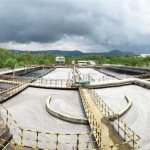Mr. Pavan Khaitan, Managing Director, Kuantum Papers Ltd., gives an outline of the water treatment strategies of their production plant, and the investment in strengthening the water treatment infrastructure.
Our water treatment process and wastewater treatment strategies…

We, at Kuantum Papers, have a focused approach toward water conservation initiatives. In the last year, we have implemented water conservation measures to reduce freshwater consumption by 2500 m³/day or 6 m³/tonne of paper.
Kuantum has been supplying treated effluent to approximately 2050 acres of land outside its premises for farming. The company has laid down 15 kms of pipeline and five pump sets for the supply of treated water for irrigation in the surrounding villages. As there is no source of surface water nearby, so we are maintaining the entire irrigation network to ensure daily supply of treated effluent to the fields. Thus, we are supporting our community of farmers and have supplemented their livelihood.
White water from machines is processed through the disc filter & Micro Plate Settler (MPS) and is then recycled and used back at paper machines. Clarified water is 100 percent recycled back and re-used for dilution of the pulp and consistency regulation and at wire showers at machines.
Effluent Treatment Process
We have a full-fledged wastewater treatment process that consists of an equalisation tank followed by clarifiers, an activated sludge plant and bio-clarifier and Upflow Anaerobic Sludge Bed (UASB) reactor. Effluent treatment facility at Kuantum Papers is divided into two streams:
- Wastewater from agro wet washing lines is handled through the bio-clarifier followed by UASB to generate methane gas which is burnt at power boilers.
- Wastewater from the rest of the plant is fed to the full-fledged effluent treatment plant consisting of equalisation tank followed by clarifiers & activated sludge plants.
Watch: Evolution of Paper Based Packaging
Our investment into water treatment infrastructure…
Kuantum Papers Ltd. has been continuously investing in various freshwater conservation initiatives and wastewater treatment processes. In the last three years, we have invested around INR 30 crores in such measures.
Water consumed per tonne of paper produced…
During FY 21-22, water consumption at Kuantum Papers was 48 m³ per ton of paper.
Also Read: Kuantum Papers: Transformational Growth Underpinned on Consistent Innovations and Upgradations
Measures undertaken to minimise the consumption…
Technologies used at our plant to reduce freshwater consumption are as below:
- Installation of disc filters at paper machines for fiber recovery and reuse of clarified water on the same machines.
- Installation of conical save-alls at paper machines for fiber recovery and clarification of white water and reuse at the same machine.
- Use and installation of Micro Plate Settlers (MPS) technology for fiber recovery and white-water clarification and re-use of clarified water at the machines.
- Installation of new state-of-the-art Dissolved Air Floatation (DAF) technology viz. Megacell high-performance filter which is especially used for wet washing filtrate to achieve outlet TSS levels < 300 ppm followed by triple wire sludge dewatering press for sludge handling.
- Handling of high chemical oxygen demand (COD) in wastewater through bio-clarifier followed by the UASB reactor which produces methane gas as a by-product which is further used at the power boilers as a fuel.
- Recycling back the hot water from the heat exchangers through the cooling tower back into the process.
- Use of Volute Press equipment technology for handling of secondary sludge at the effluent treatment plant (ETP).
- Installed Triple Wire Belt Press at ETP to handle the underflow sludge from the primary clarifier.
- Construction of white water clarifier using High Rate Solid Contact Clarifier (HRSCC) to handle excess white water from paper machines for fiber recovery and reuse of clarified water back to process.
Conscious efforts are being made through various projects to further reduce freshwater consumption by 5 m³/tonne of paper.



